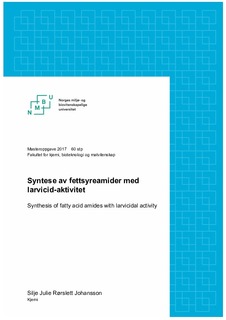| dc.contributor.advisor | Stenstrøm, Yngve | |
| dc.contributor.advisor | Hansen, Trond Vidar | |
| dc.contributor.advisor | Antonsen, Simen Gjelseth | |
| dc.contributor.advisor | Nolsøe, Jens Mortansson Jelstrup | |
| dc.contributor.author | Johansson, Silje Julie Rørslett | |
| dc.date.accessioned | 2017-10-04T11:49:40Z | |
| dc.date.available | 2017-10-04T11:49:40Z | |
| dc.date.issued | 2017 | |
| dc.identifier.uri | http://hdl.handle.net/11250/2458379 | |
| dc.description.abstract | Målet for oppgaven var å lage et bibliotek bestående av fettsyreamider fra forskjellige fettsyre- og amidderivater. Bakgrunnen for dette var forskning som gikk ut på å teste forskjellige fettsyreamider for biologisk aktivitet mot innvollsormen Toxocara Canis, og hvor linoleylpyrrolidilamid fikk best resultater. Samtidig var det et ønske å teste ut en ny amidbindingsprotokoll utviklet ved syntese-teamet på NMBU etter idé av Jens M. J. Nolsøe.
Protokollen som ble benyttet i denne oppgaven gikk ut på å bruke karbonyldiimidasol (CDI) som koblingsreagens, for å danne amidbindingen mellom de forskjellige fettsyrene og aminene.
Det ble til sammen laget 24 forskjellige fettsyreamidderivater. Resultatene fra de forskjellige forsøkene har gitt meget gode resultater, med utbytter på minst 93 % eller høyere. Det er trolig flere årsaker til de gode resultatene fra amidbindingsreaksjonene: I tillegg til at acetyleringsreaksjonen er irreversibel ved at det blir skilt ut CO2, fungerer også imidasol som en svak base, slik at eventuelle hydroklorider reagerer raskt over til de tilsvarende basene. Reagenset er også svært mildt, og foregår under tilnærmet nøytrale betingelser slik at fettsyren ikke blir deprotonert. Videre arbeid vil bestå i å sende fettsyreamidderivatene til biologisk testing. | nb_NO |
| dc.description.abstract | The purpose of this master thesis was to make a library consisting of different fatty acid amide derivatives. The synthesis is based on research that consider the possibility to use fatty acid amides as a therapeutic against the Toxocara Canis larvae. In this research, the pyrrolidine amide of linoleic acid displayed good biological activity against the larvae. Furthermore, there was a wish to test out a newly developed protocol for amide bond formation established at the synthesis team at NMBU, by an idea of Jens M. J. Nolsøe.
The protocol used in this paper involves the use of karbonyldiimidasol (CDI) as main coupling reagent to do the amide bond formation between the different fatty acids and amines.
24 different fatty acid amides derivatives were produces, which all gave yields above 93 %. In general, the crude products obtained were chemical pure. There are probably several reasons for these good results: The coupling reagent is very efficient due to the irreversible nature of the reaction after the acyl halide is formed. CDI is also a very mild reagent, and the conditions are almost pH neutral. In addition, the imidazole can react as a mild base with hydrochlorides to give the corresponding base. Imidazole is also easily removed by extraction. Future work will consist of submitting the library of compounds to test for biological activity. | nb_NO |
| dc.language.iso | nob | nb_NO |
| dc.publisher | Norwegian University of Life Sciences, Ås | nb_NO |
| dc.rights | Attribution-NonCommercial-NoDerivatives 4.0 Internasjonal | * |
| dc.rights.uri | http://creativecommons.org/licenses/by-nc-nd/4.0/deed.no | * |
| dc.subject | Organisk kjemi | nb_NO |
| dc.subject | Karbonyldiimidasol | nb_NO |
| dc.title | Syntese av fettsyreamider med larvicid-aktivitet | nb_NO |
| dc.title.alternative | Synthesis of fatty acid amides with larvicidal activity | nb_NO |
| dc.type | Master thesis | nb_NO |
| dc.description.version | submittedVersion | nb_NO |
| dc.subject.nsi | VDP::Matematikk og Naturvitenskap: 400::Kjemi: 440::Organisk kjemi: 441 | nb_NO |
| dc.source.pagenumber | 140 | nb_NO |
| dc.description.localcode | M-KJEMI | nb_NO |

